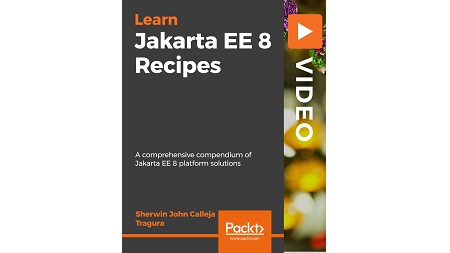
English | MP4 | AVC 1920×1080 | AAC 48KHz 2ch | 6 Hours | 3.20 GB
Create effective and reliable enterprise solutions with Jakarta EE 8 specifications
Do you wish to deliver really awesome enterprise solutions with the most robust and mature technology for enterprise development? This course will help you build effective enterprise solutions and become productive with Jakarta EE 8.
In this course, you will start by writing request-response transactions using Jakarta EE 8’s sole container, Servlet 4.0. You will implement features in Jakarta EE by writing EJB 3.2 and JSF 2.3 web applications; build MVC applications using Eclipse Ozar; implement server-side components using CDI 2.0; and build REST services. You will also learn to improve the security of your enterprise solutions using built-in authentication and hard-coded authorization. And finally, you will learn to deploy your Jakarta EE applications and microservices on various reliable and secure servers.
By the end of the course, you will be using Jakarta EE 8 to develop a secure, effective, and reliable enterprise application.
Learn
- Understand all the major components of the Jakarta EE platform
- Build complete client-server applications using the Jakarta EE 8 specification
- Translate features created using Java EE 8 to Jakarta EE
- Implement request-response transactions using Servlet 4.x containers
- Build and implement Jakarta EE components with Context Dependency Injection (CDI) 2.0
- Apply authentication and authorization to applications using the Jakarta EE security model
- Build and deploy Jakarta EE microservices locally or through cloud-based servers
Table of Contents
Exploring Servlet 4.0
1 The Course Overview
2 Setting Up HTTP 2
3 The Server Push
4 Managing Request and Response
5 Applying CDI 2.0
6 Creating Filter Components
7 Creating Listeners
8 Adding Servlets at Runtime
9 Managing Views Using Runtime Discovery
Implementing Jakarta EE Components
10 Using EJB 3.2 Lite with CDI 2.0
11 Creating Interceptors 1.2
12 Building JSF 2.3 MVC with CDI 2.0
13 Method Invocation with Ajax
14 Applying Interceptors and Events to JSF 2.3
15 Applying Event Ordering Mechanism
16 Creating Asynchronous Events
17 Using Eclipse Krazo MVC
Managing the Data Model
18 DAO with JPA 2.2 and Bean Validation 2.0
19 Using JTA for Single Datasource
20 JPA Layer in EJB 3.2
21 Using Hibernate JPA Provider
22 Using EclipseLink JPA Provider
23 Setting Up Multiple Datasources
24 Creating NoSQL Data Layer
Using JSON-Based Utilities
25 Applying JSONB and JSONP Operations
26 Mapping Date Properties
27 Using JsonPointer
28 Applying JsonPatch and MergePatch
29 Using JSON Queries
Building Asynchronous and Reactive Applications
30 Creating Asynchronous Servlets and Filters
31 Using Stream Process Blocks
32 Implementing REST Services Using JAX-RS 2.1
33 Creating Clients for JAX-RS 2.1 Web Services
34 Implementing Asynchronous Message-Driven Transactions
35 Building Server Sent Events (SSE)
36 Creating WebSocket Applications
37 Using HTTP Trailers
Building Concurrent Applications
38 Using Thread Executors
39 Creating and Using ManagedExecutorService
40 Creating and Using ManagedScheduledExecutorService
41 Using ManagedThreadFactory
42 Using ContextService
Applying Security to Jakarta EE
43 Implementing Basic Authentication
44 Using IdentityStore
45 Storing User Credentials in a Database
46 Managing User Roles and Authorization
47 Implementing Form-Based Authentication
48 Using Cookies to Create Authentication
49 Using SecurityContext
50 Securing Other Resources
Deploying and Running Jakarta EE Applications
51 Using Open Liberty
52 Using Payara
53 Using GlassFish
54 Using WildFly
55 Using Jetty
Building Microservices and Cloud-Native Applications
56 Building Microservices Using Thorntail
57 Building Microservices Using Payara Micro
58 Building Microservices Using KumuluzEE
59 Building Cloud-Native Application Using Docker
60 Accessing Other Container Applications
61 Creating Cloud-Native Application Using AWS
Resolve the captcha to access the links!